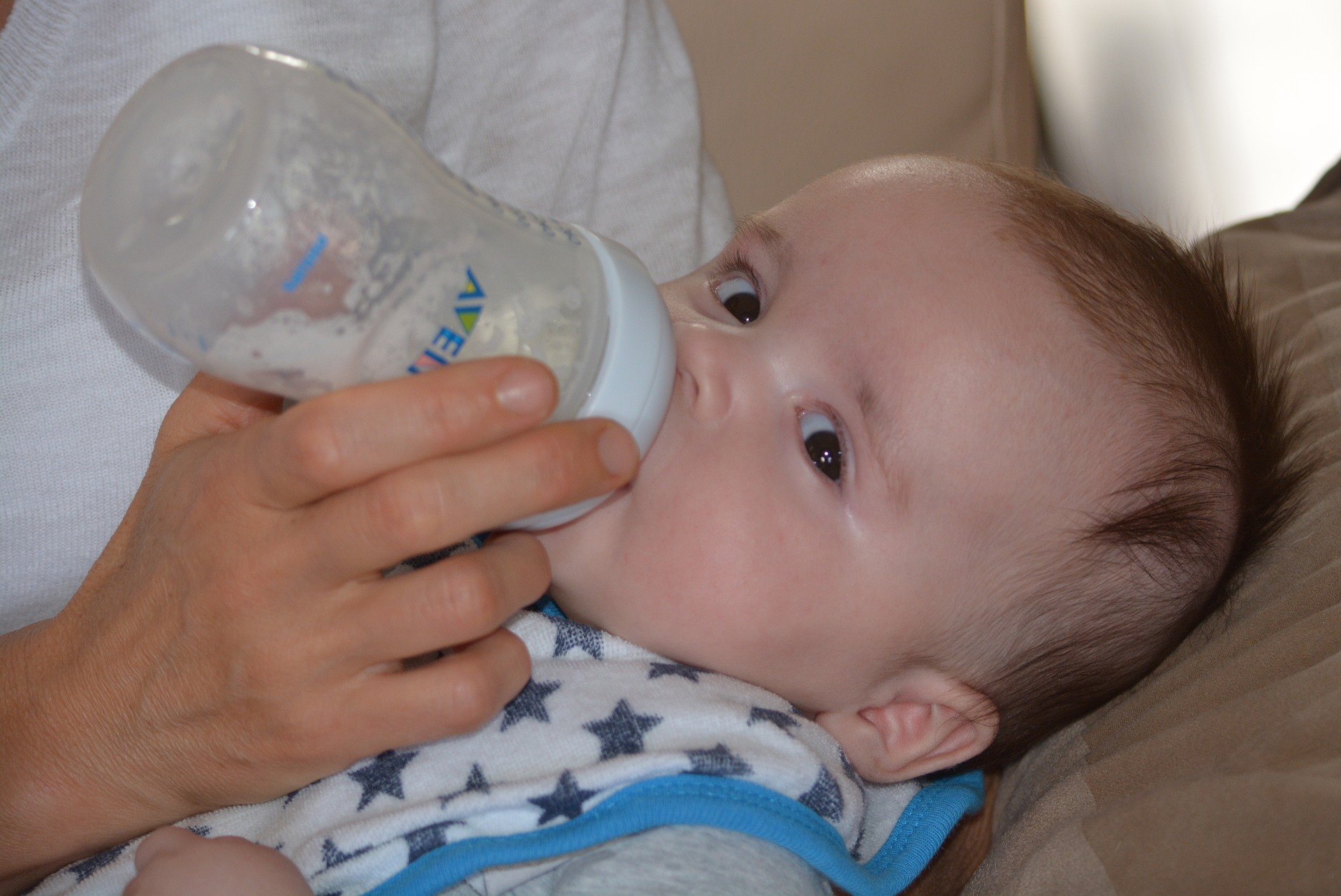Similac Alimentum and Enfamil Nutramigen are both clinically proven hypoallergenic formulas. Either of these can be an excellent choice for your baby if they have CMA (Cows Milk Allergy) or colic.
Want to know which formula would be better for your child’s needs then ready my article below. One of my four kids had issues and it was harder feeding him than the other three kids combined!
Choosing between Alimentum or Nutramigen can be tough. Both have good reviews and contain great ingredients. This article will discuss what the formulas are good for, the nutritional values, and the pros and cons of each formula. While I had a favorite with a bias toward Enfamil over the years, the Similac versions can work better for some, so testing is the key here people!
Table of Contents
- What These Baby Formulas Work for
- Similarities Between Similac Alimentum and Enfamil Nutramigen
- Key Differences Between Alimentum and Nutramigen
- Nutritional Facts
- Pros and Cons of Each Formula
- Alimentum
- Nutramigen
- Final Verdict – Alimentum vs Nutramigen
What These Baby Formulas Work for
Some babies develop an allergy to cow’s milk or colic while switching from breast milk to formula. It is because most formulas use cow’s milk protein as a base.
The Similac Alimentum and the Enfamil Nutramigen are two of the best formulas on the market that claim to reduce allergic reactions and colicky symptoms in babies from cow’s milk.
- Similac Alimentum
The Similac Alimentum uses a hydrolyzed casein formula to reduce cow’s milk allergy or CMA in babies. It contains 2′- FL that helps with allergies in babies. 2′- FL or 2′ Fucosyllactose is a milk oligosaccharide that is found most abundantly in human breast milk.
2′- FL increases immunity and promotes a healthier gut. It can decrease the risks of respiratory inflammation, infection, and eczema in infants.
The Similac Alimentum is clinically proven to be an efficient hypoallergenic formula that can quickly mitigate symptoms of CMA.
With Similac Alimentum, you don’t have to switch formulas at 6 months and can start feeding at birth. It is prepared according to the guidelines provided by the NHS and the WHO. Find more info here.
- Enfamil Nutramigen
The Enfamil Nutramigen is a hypoallergenic formula that claims to reduce colic in babies due to CMA within 48 hours. It contains hydrolyzed proteins that lessen allergic reactions in babies and are lactose-free. It also reduces the recurrence of allergies in the future.
The Enfamil Nutramigen contains DHA and ARA to support brain and eyesight development. It helps babies reduce reaction to CMA and resume consumption of regular milk within 6 months. You can find more about Nutramigen here.
Similarities Between Similac Alimentum and Enfamil Nutramigen
The Alimentum and the Nutramigen are similar formulas that treat colic and CMA in babies. The similarities between them are given in my list below:
- Both formulas contain extremely hydrolyzed proteins.
- Casein is hydrolyzed in both formulas which are commonly found in milk.
- Both of these formulas are free of lactose and soy.
- Soy oil is an ingredient in both products. It is highly refined and does not trigger any allergic reaction.
- Both contain DHA and ARA. The ARA is derived from Mortierella Alpina oil which is also high in Omega-3 fatty acids. ARA helps immune system development in babies.
- The Similac Alimentum contains corn maltodextrin while the Enfamil Nutramigen contains corn syrup. Both are nearly similar although corn syrup has more sugar.
- Both are iron-fortified containing over 1 mg of iron in every 100 calories.
- The formulas contain no artificial growth hormones but do have processed vegetable oils.
Nutritional Values
The following nutrients exist in similar quantities in both Similac Alimentum and the Enfamil Nutramigen.
- Vitamin A and B6
- Vitamin D3
- Vitamin B2 (Riboflavin)
- Iodine
- Copper
Key Differences Between Alimentum and Nutramigen
The Similac Alimentum and the Enfamil Nutramigen have some key differences in their nutritional values and ingredient lists.
Similac Alimentum
- Babies with protein sensitivity cry during feeding. Similac Alimentum is proven clinically to reduce crying and fussiness in babies which normally occurs due to sensitivity to protein within 24 hours of consumption.
- It contains medium chain triglycerides ( MCT) which are easier for babies to digest.
- The Alimentum contains 105 gm of calcium which is more than the 94gm that is available in Nutramigen. It doesn’t contain any palm oil.
- It costs less than Nutramigen. Nutramigen can cost around $45.99 for a 19.8 oz can whereas the Alimentum costs $39.99 for the same size can. Note that these prices may vary but are current as of my writing.
- Similac Alimentum contains more total fats, calcium, vitamin B12, pantothenic acid, phosphorus, biotin, niacin, linoleic acid, Vitamin E, and potassium than Nutramigen.
Enfamil Nutramigen
The following features of Nutramigen make it different from Alimentum
- Nutramigen is proven clinically to reduce colicky symptoms in babies due to CMA within the initial 48 hours.
- Mead Johnson claims that feeding Nutramigen to your baby reduces the possibility of potential allergies of eczema, hives, asthma, and rhinitis.
- The Enfamil Nutramigen contains probiotics derived from the Lactobacillus rhamnosus GG (LGG) culture strain. The probiotics enable the production of good bacteria in your baby’s guts that help improve digestion.
- The Nutramigen contains no added sugar.
- Nutramigen contains more Carbohydrates, protein equivalent, vitamin C, K, B1, folic acid, chloride, choline, sodium, inositol, zinc, selenium, magnesium, and manganese than Alimentum.
Nutritional Facts
Similac Alimentum
Ingredients
Refer to the product packaging for the complete list of ingredients.
Casein hydrolysate, Corn Maltodextrin, Sugar, High Oleic Safflower Oil, Soy Oil, Medium-Chain Triglycerides, Crypthecodinium cohnii oil (DHA), Mortierella alpina oil (ARA).
Nutritional Value
You should check the website or product packaging for a more accurate list of nutritional values.
The Similac Alimentum contains 100 calories, 5. 54 gm of Total fats, 10. 2 gm of Title Carbohydrates, 2. 75 gm of Protein equivalent, 1.8 mg of fortified iron, and 105 mg of Calcium.
Vitamins
300 IU of Vitamin A, 60 McG of Vitamin B6, 9 mg of Vitamin C, 60 IU of Vitamin D3, 3 IU of Vitamin E, 8 McG of Vitamin K.
800 mg of Linoleic acid, 60 McG of Thiamin (B1), 90 McG of Riboflavin (B2), 1350 McG of Niacin, 15 McG of Folic acid, 750 McG of Pantothenic acid, 4.5 McG Biotin, 12 mg Choline, 5 mg Inositol.
Minerals
Mineral amounts are listed according to the data on their website
- 75 mg of Phosphorus
- 7.5 mg of Magnesium
- 80 mg Chloride
- 0. 75 mg Zinc
- 118 mg of Potassium
- 8 McG Manganese
- 44 mg of Sodium
- 75 mcg of Copper
- 2 McG of Selenium
- 15 McG of Iodine
The above quantity of nutritional value is applicable per serving of 5 fluid ounces of formula.
Refer to the product packaging for the updated list of ingredients and nutritional value.
Enfamil Nutramigen
Ingredients of Nutramigen
These are the most featured list of ingredients of Nutramigen. Check product packaging for the complete list.
Casein Hydrolysate (Modified), Solids of Corn Syrup, Vegetable Oil, Corn Starch (Modified), Probiotics (Lactobacillus rhamnosus), ARA (Mortierella Alpina oil), and DHA (Schizochytrium sp. oil).
Nutritional Values
5 fluid ounces of Nutramigen contains the following.
100 Calories, 5.3 gm of Total fats, 10.3 gm of Total carbohydrates, no added sugar, 2.8 gm of protein equivalent, 1.8 mg of fortified iron, and 94 mg of Calcium.
Vitamins
The following list is given as per the information available on the product’s website.
300 IU of Vitamin A, 60 McG of Vitamin B6, 12 mg of Vitamin C, 60 IU of Vitamin D3, 2 IU of Vitamin E, 9 McG of Vitamin K, 780 mg of Linoleic acid, 80 McG of Thiamin, 90 McG of Riboflavin, 0.3 McG of Vitamin B12, 1000 McG of Niacin, 16 McG of Folic acid, 500 McG of Pantothenic acid, 3 McG of Biotin, 24 mg Choline, 24 mg Inositol.
Minerals
- 52 mg of Phosphorus
- 86 mg of Chloride
- 8 mg of Magnesium
- 110 mg of Potassium
- 1 mg of Zinc
- 47 mg Sodium
- 25 McG of Manganese
- 2.8 McG of Selenium
- 75 McG of Copper
- 15 McG of Iodine
See product packaging for the updated and most accurate information on ingredients and nutrition.
Pros and Cons of Each Formula
Alimentum
The Pros and Cons of Similac Alimentum are given below.
Pros
- Clinically proven as a hypoallergenic formula.
- Medium-Chain Triglycerides (MCT) are easier for babies to absorb in the gut.
- Doesn’t contain palm oil which negatively affects calcium absorption in babies.
- No product recalls for the powder version.
Cons
- Contains added sugars.
- Contains Maltodextrin and vegetable oils.
- Contains soy oil.
Nutramigen
The pros and cons of Nutramigen are given below.
Pros
- It is lactose-free.
- Contains probiotics that promote the growth of healthy bacteria in the guts.
- Doesn’t contain artificial growth hormones.
- Doesn’t contain added sugars or sucrose.
- It contains DHA and ARA that ensure proper development of the brain and eyes.
- Has been proven to successfully reduce allergic reactions and rashes.
Cons
- Contains corn syrup
- Contains soy oil that is highly refined and may contain soy particles. Beware if your baby has a soy allergy.
- Contains palm oil and other vegetable oils that may interfere with calcium absorption in babies.
- The Enfamil Nutramigen was recalled in 2001 due to misinformation in the product packaging.
- Costlier than the Similac Alimentum.
Both formulas taste good and don’t have any bad smell. However, babies have different tastes and should be given the formula they like. Remember that breast milk is the best source of nutrients for infants.
Final Verdict – Alimentum vs Nutramigen
Being a mom of four and around the block with baby formula over the last two decades I can tell you there is not a one stop shop type of answer. Any one that tells you there is only one way is not thinking from all aspects. Each child is a unique soul and should be treated as such. If one type of formula does not work, do not be afraid to keep trying.
Alimentum and Nutramigen are both good formulas for babies with allergies. Both are formulated to reduce colicky symptoms and CMA. Both formulas have different nutritional values. Hopefully, you’ve found this article useful as I try to write about all the different baby formulas. These specialty formulas are vital to the health of babies.
Each baby and its digestive system is different. A well-reviewed formula may not work well for your baby.
Try samples before investing in a big can and ask your pediatrician which formula would be best for you.
Often times there are free samples or if the formula is specialized enough it may be eligible for insurance.
With love,
Sharon











